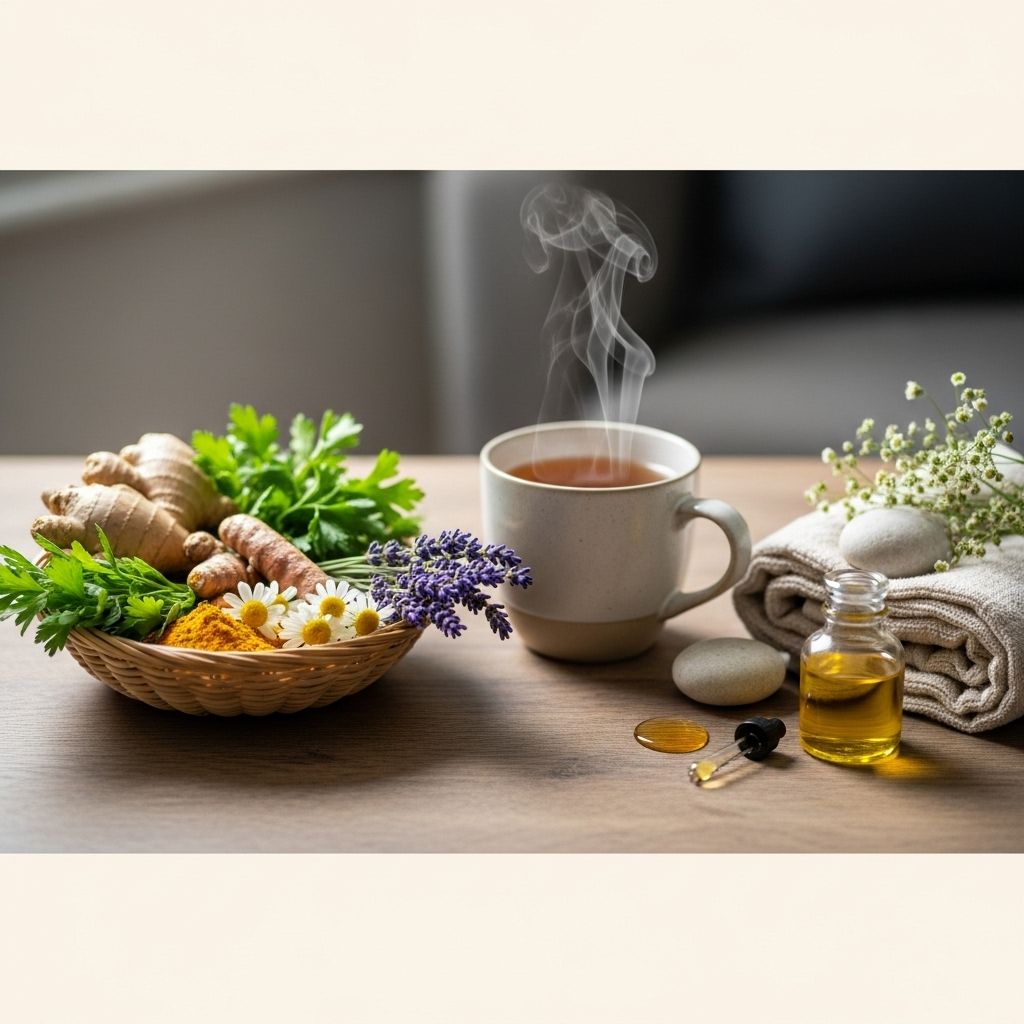10 Effective Home Remedies to Heal Adenomyosis Naturally
Integrate simple self-care treatments and dietary tweaks to manage uterine discomfort.

Adenomyosis is a chronic gynecological condition where the uterine lining invades the muscular wall of the uterus, causing severe pelvic pain, heavy menstrual bleeding, and overall disruption to reproductive health. While medical treatments are available, many women seek home remedies and lifestyle changes that provide safe, complementary relief. This article presents a comprehensive overview of 10 effective home remedies, alongside dietary recommendations, symptom management strategies, and answers to frequently asked questions about adenomyosis.
Table of Contents
- What is Adenomyosis?
- 10 Home Remedies for Adenomyosis
- Dietary Recommendations for Adenomyosis
- Causes and Risk Factors
- Role of Traditional Chinese Medicine
- Frequently Asked Questions (FAQs)
What is Adenomyosis?
Adenomyosis refers to the abnormal growth of endometrial tissue (uterine lining) into the muscle wall of the uterus, leading to chronic inflammation, longer and heavier menstrual periods, and intense uterine cramping. The condition is most common in women between ages 35 and 50, but it can affect women of other ages as well. Over time, adenomyosis may result in the formation of blood clots during menstruation and progressive scarring of the uterine wall.
10 Home Remedies for Adenomyosis
Natural remedies can help reduce pain, control bleeding, and improve day-to-day comfort for women with adenomyosis. While not a substitute for professional medical care, these home-based strategies can be safely integrated into your routine.
1. Heating Pads
- Purpose: Enhances blood flow to the pelvic region, relaxes muscles, relieves pain and pressure.
- How to Apply:
- Place a heating pad directly on your lower abdomen.
- Keep in place for 5 minutes, then remove.
- Repeat thrice during a session.
- Frequency: 2-3 times daily, or whenever pain occurs.
2. Aromatherapy Massage
- Purpose: Stimulates abdominal blood flow, relieves menstrual cramps, promotes muscle relaxation.
- How to Apply:
- Mix 6 drops of your chosen essential oil (lavender, clary sage, or peppermint) with 1 teaspoon of coconut oil.
- Gently massage onto abdomen for 2 minutes.
- Leave on overnight or at least 30-40 minutes before rinsing off.
- Frequency: 1-2 times daily, especially during menstruation.
3. Castor Oil Packs
- Purpose: Castor oil’s ricinoleic acid is a powerful anti-inflammatory agent; packs help reduce uterine swelling and pain.
- How to Use:
- Apply castor oil generously to the lower abdomen.
- Cover with a clean cloth and place a hot water bottle on top.
- Leave for 15–20 minutes.
- Frequency: 1-2 times a day.
4. Shepherd’s Purse Herbal Tea
- Purpose: Promotes healthy blood circulation, provides relief from heavy and irregular bleeding.
- Preparation:
- Add ½ teaspoon shepherd’s purse to 1 cup water. Bring to a boil, simmer, strain, and drink.
- Frequency: 3-4 times daily, especially before and during periods.
5. Ginger Tea
- Purpose: Acts as an anti-inflammatory and analgesic, reduces uterine pain and swelling.
- Preparation:
- Boil 1 teaspoon minced ginger in 1 cup water, strain, add honey, and drink.
- Frequency: 3-4 times daily.
6. Turmeric
- Purpose: Turmeric is widely recognized for its potent anti-inflammatory and antioxidant properties. It may help alleviate inflammation in uterine tissues, reduce menstrual pain, and regulate bleeding.
- How to Use:
- Add turmeric to daily meals, smoothies, or consume as a warm turmeric-ginger tea.
- Frequency: Once or twice daily.
7. Aloe Vera Juice
- Purpose: Aloe vera has soothing effects on inflamed tissues and may help manage pain and swelling.
- How to Use:
- Drink fresh aloe vera juice (½ cup) on an empty stomach in the morning.
- Frequency: Daily.
8. Dietary Fiber (Whole Grains, Fruits, Vegetables)
- Purpose: Fiber-rich foods support hormonal balance and gut health, both crucial for managing adenomyosis symptoms.
- Key sources: Whole grains, grapes, apples, cabbage, spinach, mint, cumin.
9. Systemic Enzyme Therapy
- Purpose: Systemic enzymes help digest and “eat away” excess tissue growth, reduce pain, lower inflammation, and prevent scar tissue damage.
- How to Use: Available as oral supplements (consult a healthcare provider before use).
10. Herbal Tinctures and Blends
- Purpose: Specific herbal blends have shown promise in reducing heavy menstrual bleeding, modulating hormones, and alleviating pain.
- Examples:
- Women’s Best Friend™: Contains herbs and enzymes for uterine health, heavy bleeding, and pain management.
- Anti-Adenomyosis Tincture: Blends of licorice root, partridge berry leaf, blue cohosh root, geranium root, and cotton root bark.
- Suggested Dosage: 1 dropperful, twice daily (formulations may vary; consult an herbalist).
Dietary Recommendations for Adenomyosis
Optimizing your diet can help regulate hormone levels, reduce inflammation, and promote general well-being. Consider these dietary tips:
- Favor:
- Whole grains (brown rice, oats, quinoa)
- Leafy greens (spinach, kale, cabbage)
- High-antioxidant fruits (grapes, apples, berries)
- Pain- and inflammation-minimizing spices (turmeric, ginger, mint, cumin)
- Limit:
- Red and processed meats
- Refined sugars
- Saturated fats and trans fats
- Caffeinated and overly processed foods
- Supportive nutrients:
- Magnesium, iron, and vitamin B complex (for energy and pain management)
- Omega-3 fatty acids (from flaxseed, walnuts, chia seeds, and oily fish)
Causes and Risk Factors for Adenomyosis
| Factor | Description |
|---|---|
| Hormonal fluctuations | Imbalances in estrogen and progesterone may trigger abnormal tissue growth. |
| Uterine trauma | Previous uterine surgeries, childbirth, or D&C procedures may disrupt muscle layers. |
| Age | Most common in women aged 35-50 years. |
| Genetic predisposition | Family history can increase risk. |
| Chronic inflammation | Ongoing uterine inflammation may encourage abnormal tissue migration. |
Adenomyosis is a lifelong condition with fluctuating intensity, and proactive symptom management is essential for maintaining quality of life.
Role of Traditional Chinese Medicine (TCM)
TCM has developed individualized treatments for adenomyosis focused on promoting circulation and eliminating “blood stasis.” Remedies include herbal capsules, decoctions, acupuncture, and acupoint applications. Some popular formulas are:
- Guizhi Fuling Capsule: Reduces symptoms and improves uterine health.
- Shaofu Zhuyu Decoction (modified): Focuses on pain and blood flow regulation.
- Acupuncture and catgut embedding: Targeted therapies for symptom alleviation.
Consult a qualified TCM practitioner for individualized evaluation and safe integration of alternative therapies with conventional medical interventions.
Frequently Asked Questions (FAQs)
Q1: Is there a permanent cure for adenomyosis?
Adenomyosis is a chronic gynecological disorder, and most non-surgical treatments aim to manage rather than cure. Radical treatments like hysterectomy may eliminate the condition but result in loss of fertility. Home remedies and lifestyle changes focus on symptom relief and improving quality of life.
Q2: Can adenomyosis affect fertility?
Yes. Adenomyosis can impair fertility by disrupting the normal structure and function of the uterus, but many women maintain reproductive potential with proper symptom management and medical support.
Q3: How are the symptoms of adenomyosis characterized?
- Persistent pelvic pain and pressure
- Very heavy and prolonged menstrual periods
- Severe menstrual cramps
- Blood clots during periods
- Chronic fatigue and anemia (from heavy bleeding)
Q4: Can dietary changes alone manage adenomyosis?
Dietary changes are an essential part of symptom management, especially for pain, inflammation, and menstrual regulation. However, they work best in combination with other home remedies and professional medical guidance.
Q5: Are herbal remedies and supplements safe?
Many herbs and supplements are considered safe when used under guidance, but interactions may occur. Consult a healthcare professional before starting any new herbal protocol, especially if you take prescription medications or have other health conditions.
Infographic: 5 Easy Home Remedies for Adenomyosis
- Heating pads: Immediate comfort for cramping.
- Massage with essential oils: Relieves pelvic pressure.
- Castor oil packs: Reduce swelling and pain.
- Ginger tea: Reduces inflammation.
- Shepherd’s purse: Controls heavy bleeding.
Adenomyosis can be managed successfully with integrated home-based care, appropriate dietary interventions, and collaboration with medical and alternative health practitioners. Listen to your body, experiment sensitively with remedies listed above, and prioritize both symptom management and long-term well-being. For persistent symptoms, heavy bleeding, or reproductive concerns, consult a gynecologist or integrative healthcare specialist.
References
- https://www.stylecraze.com/articles/effective-ways-to-cure-adenomyosis-at-home/
- https://natural-fertility-info.com/adenomyosis-causes-risks-natural-healing-options.html
- https://pmc.ncbi.nlm.nih.gov/articles/PMC10098355/
- https://gpm.amegroups.org/article/view/8440/html
- https://www.spandidos-publications.com/10.3892/etm.2020.8994
- https://www.stylecraze.com/author/sucharitamishra/
Read full bio of medha deb












